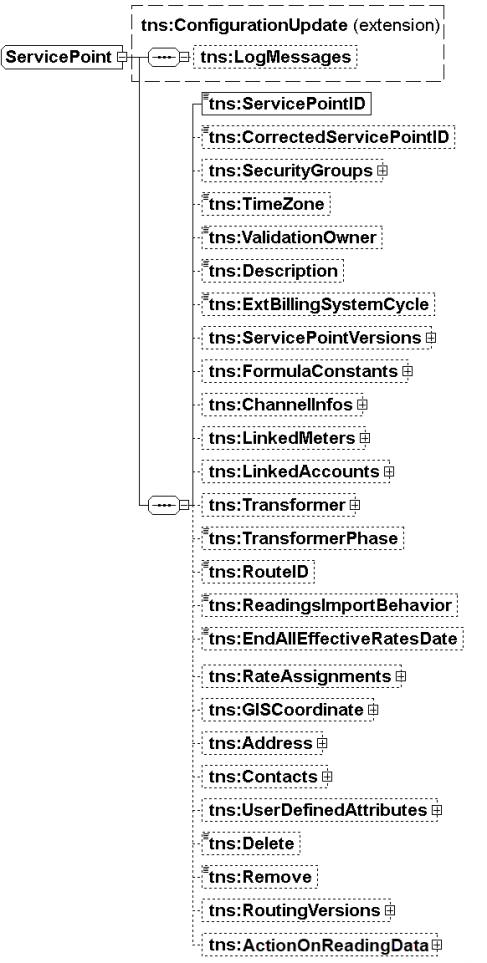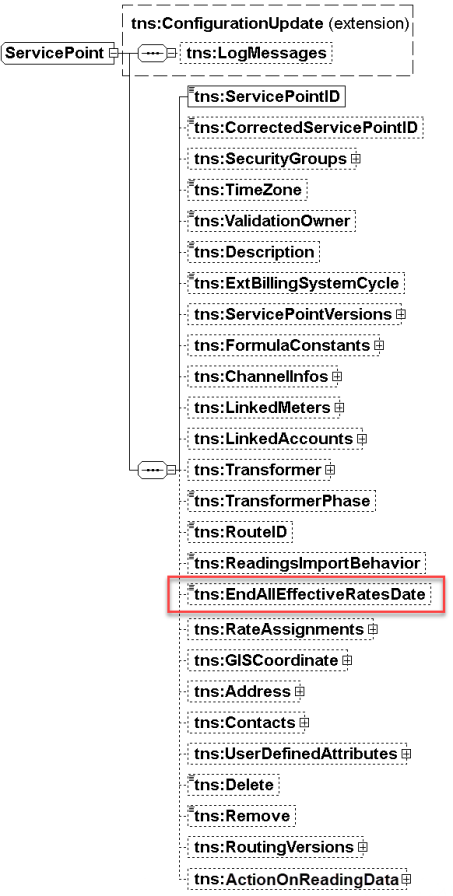Service point instance
Use the ServicePoint element to define a service point instance. Any properties not specified when creating the instance either come from the service-point program or set to default values.
The ServicePointVersions element specifies properties that can change over time, and is specifically intended to support service point reprograms over time.
The following illustration shows the ServicePoint element schema:

The Service Point Instance comprises the following elements:
- Configuration Update. Defines the base class for a stand-alone configuration element.
- LogMessages. Defines the log messages returned by the service. It only holds messages when the update is part of a transaction. In that case, the log messages only describe the problems about the single update.
- ServicePointID. Defines the unique identifier for the Service Point. The identifier is limited to 100 characters. Required.
- CorrectedServicePointID. Defines an import-only field containing a new ID for the Service Point. Used only to make a correction to an existing Service Point.
- SecurityGroups. Defines the security groups for the Service Point to define data-level security. The IDs must match security groups that exist in IEE.
- TimeZone. Defines the time zone of the meter. The ID must match a reference ID for a time zone set up in IEE.
- ValidationOwner. IEE no longer uses this element. It always returns String.Empty.
- Description. Defines a description for the Service Point channel. The description is limited to 100 characters.
- ExtBillingSystemCycle. Defines the ExtBillingSystemCycle for the Service Point channel. This ID must match an ExternalBillingSystemCycleID defined in IEE's code table. The value is used to prioritize actions on a Service Point. If the CIS needs to indicate the billing cycle for this Service Point, it must create the code table entry and then assign the Service Point to that cycle.
- ServicePointVersions. Defines a collection of temporal data for the Service Point. The only temporal data for a Service Point is the Service Point program.
- FormulaConstants. Defines a formula constant for the Service Point. Formula constants assigned at the Service Point level have temporal values.
- ChannelInfos. Defines channel-based information for the Service Point. These elements contain all per-channel-based information for a Service Point instance.
- LinkedMeters. Defines meters linked to the Service Point. This element is used only for initial linking or replacing linkage. More complex link changes must use the MeterChange element. This can either define an existing Service Point or create a new Service Point instance (along with a new Meter instance). It is a collection. This supports the case when a Service Point has more than a single meter assigned to it.
- LinkedAccounts. Defines the accounts or customer to which the Service Point is linked. It can define existing accounts, or can create a new account instance. It is created along with the link to the Service Point instance. You can also include the customer to define the complete linkage of the account.
- Transformer. Defines a transformer associated with the Service Point. It can update an existing transformer or create a new one.
- TransformerPhase. Defines the transformer phase of the Service Point's transformer. The valid values are A, AB, ABC, AC, B, BC or C
- RouteID. Defines the route ID of the Service Point. The route ID must point to an existing route.
- ReadingsImportBehavior. Defines the ReadingsImportBehavior which determines the action taken on readings during import. The valid values are as follows: ExcludeReadingsFromAmiImport and IncludeReadingsInAmiImport. This can handle differences such as automatic estimation which is always done when the value is IncludeReadingsInAmiImport. The default value is IncludeReadingsInAmiImport.
- EndAllEffectiveRatesDate. (Optional) Determines whether the rates that are assigned to the Service Point need to end. If the date is set, all rates assigned to the service end as of the date. Any new rate assignments specified in the RateAssignment element are applied (if they are provided). The dates for those rate assignments are provided in each RateAssignment element.
- RateAssignments. Defines the rate assignment data. The referenced rates must exist in IEE.
- GISCoordinate. Defines the GISCoordinate of the Service Point. Coordinate types are as follows:
WorldGeodeticSystem: Also known as WGS, this type is the standard reference coordinate system for GPS.
UTM: Universal Transverse Mercator, a plane coordinate grid system named for the map projection on which it is based (Transverse Mercator). The UTM system consists of 60 zones, each 6 degrees of longitude in width. The zones number 1-60, beginning at 180 degrees longitude and increasing to the east. (usgs.gov)
StatePlane: The State Plane Coordinate System (SPCS), which is only used in the United States, is a plane coordinate system (north-south and east-west lines are perpendicular) in which each individual state has between one to six zones, depending on the state's size and shape. This coordinate system achieves its high level of accuracy through the use of relatively small zones. (usgs.gov)
GIS coordinates can be specified at the service point or meter levels.
- Address. Defines the address of the Service Point.
- Contacts. Defines the contacts for the Service Point.
- UserDefinedAttributes. Defines the user-defined attributes.
- Delete. Defines an import-only property that indicates a request to delete a matching Service Point. Any readings associated with this Service Point will cause deletion to fail. It's a cascading deletion that deletes all associated elements. Setting this flag uses only the ServicePointID to match, ignoring all other elements. Setting this flag on a ServicePoint element containing a LinkedMeters or LinkedAccounts causes rejection of the entire request.
- Remove. Defines an import-only indication of a service point's removal from a premises request. When you see this flag, you must remove this service point's association from the existing premises parent.
- RoutingVersions. Defines a collection of temporal data to link a service point and a routing program.
-
ActionOnReadingData.(Optional) All linked service point interval channels will use the value to handle their readings. Possible actions are as follows:
-
None. Same as Off in purge reading system setting.
-
KeepData. Keeps readings to allow any configuration change even interval length detected and any reading exists.
-
PermanentlyDelete. Same as PermanentlyDelete in purge reading system setting.
-
LogicalDelete. Same as same as LogicalDelete in purge reading system setting.
Note: The IEE purge reading system setting is located at System Settings > Configuration > Purge Readings to Allow Interval Length Changes.
-
To accommodate more flexible move-in and move-out scenarios and rate assignment corrections, the EndAllEffectiveRatesDate element can replace any current assigned rates with the newly provided rates.
With the EndAllEffectiveRatesDate element, you can specify when all currently effective rate assignments will end for a service point. IEE will then apply all new rate assignments specified in the RateAssignment elements. For examples of this change, see Account change operation.

- EndAllEffectiveRatesDate. Indicates if the rates that are assigned to the service point need to be ended. If this date is set, then all rates assigned to the service point will be ended as of this date. Any new rate assignments specified in the Rate Assignments element will be applied if they're provided. The dates for those rate assignments are provided in each RateAssignment element. The date specified here is only used to end the rates that are effective before applying any new rate assignments. If no RateAssignments are provided, then all effective rates are ended as of this date, and no new rates are assigned.